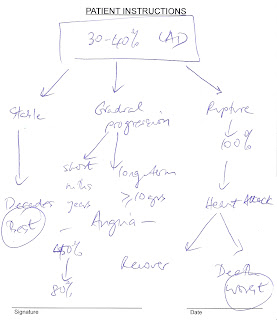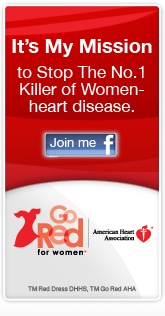This is the best news I’ve heard in a long time. And by long time, I mean since August 14, the day of my heart attack. It turns out that your body will, if you treat it properly, mount its own defense against heart disease and future heart attacks. It grows extra, natural bypass vessels where your heart needs them most.
 |
|
It’s hard to say what I love best about this diagram.
It might be the circled “best” and “worst.”
|
This is truly life-changing. At my very first cardiologist appointment, almost two months ago now, my doctor drew me this diagram while he narrated my four potential futures.
Future 1: Nothing ever happens again and I live with a 30%-40% blocked LAD and minor deposits in my other arteries for the rest of my life. (The LAD is the one they call the “widowmaker” even though more women than men die each year from heart attacks. Oops, that’s another subject.)
Future 2: My arteries continue to slowly clog up with cholesterol plaque until I become symptomatic (pain, pressure, fatigue etc.) and go in to be checked out. They do another angio, probably another stent, and I’m on my way back to rehab.
Future 3: Have another surprise heart attack due to a plaque deposit rupturing and my platelets trying like crazy to fix it and causing a clot to form. These kinds of heart attacks have no warning. I make it to the hospital, they intervene, and I live to repeat this whole experience.
Future 4: Have another heart attack and die.
At this point my eyes widened and he said, “well, you’ve already been through all this, we really don’t need to sugar coat it” or something like that.
Well, maybe we could have. At least a spoonful.
It took me a few weeks and some antidepressants to pick myself off the floor from that pep talk, informative though it was. And then I started to see these headlines:
- “Back up system reduces heart disease deaths” University College London
- “Natural bypasses can save lives” American Heart Association
- “Do-it-yourself cardiac bypass surgery: All you need is walking shoes” Harvard Health Letter
I read and bookmarked them and tried to believe it was true. Really? There’s something I can do about this? Some way I can affect my future and not just wait for one of Dr. Murad’s four futures to play out? Be still my heart.
In response to endurance exercise training (such as running, bicycling, swimming, and hiking), blood flow is increased, which leads to a conversion from capillaries into collaterals.
As . . . collateral vessels grow more muscular and interconnected, they begin to reroute some of the blood flow around the blockage. Scientists have been trying for years to nudge collateral blood vessels to develop and prosper, but without great success. However, you can do it at home without anything more high-tech than a comfortable pair of shoes.
It’s really that simple, that easy, that obvious? Just exercise? Sign me up.
 |
|
The heart on the left has lots of natural
bypasses, and less damage, than the right. |
However, the oft-repeated and comforting recommendation that any little bit of exercise helps is not true in this case. You need to work out hard, for at least 30 minutes, almost every day. It needs to be aerobic and at a high enough intensity that your blood is moving fast.
Moving blood = more collateral vessels. Easy 11-minute mile jogs are not going to cut it.
But really, being lazy is not an option. Not only do individuals who have lots of natural bypass vessels have a 36 percent greater chance of living, they also sustain less damage to their heart muscle when they do have a heart attack.
So, the best news I’ve heard in a long time is this: Exercise will likely save my life. Running a fast 10K is hard, but heart attacks are harder.
If you’re looking for me, I’m at the gym.
P.S. I actually really love Dr. Murad. After he drew that diagram, he flipped it over and wrote down his cell phone. You will likely not be surprised that I wept with relief on the spot.



Great post, Jen!
Your blog hit me at perfect time. I too am 37. I’m a mom and a writer. More of a baker than a cook. My father just had a heart attack, my mom recently had a stroke. I recently started running. Great writing — great blog!
Thank you for the comment Kate!